Air Operations, CBI
BURMA
- More than 90 10th Air Force fighter-bombers attack troops, tanks, anti-aircraft batteries, and supplies at 6 locations.
- 8 P-47s attack a Japanese Army divisional headquarters.
- 4 P-47s support Allied ground troops.
- 25 14th Air Force P-40s and P-51s attack targets of opportunity in the Wanling area.
- 3 P-40s attack road traffic near Muse.
CHINA
- 8 311th Fighter Group P-51s attack railroad repair shops at Sinsiang. Also, 6 58th Very Heavy Bomb Wing B-29s unable to reach their targets in Formosa attack targets of last resort on the China coast.
FRENCH INDOCHINA
- 6 341st Medium Bomb Group B-25s attack rail targets, road bridges, and buildings in the Thanh Moi area.
[  | |   ] ]
Air Operations, East Indies - XIII Fighter Command fighter-bombers mount numerous small attacks against various targets on Timor, Borneo, and in the Molucca Islands.
- A 419th Night Fighter Squadron P-61 crew downs a G4M 'Betty' bomber near over the Molucca Islands at 0250 hours.
[  | |   ] ]
Air Operations, Europe
US 9th AIR FORCE
GERMANY:
- 15 9th Air Division B-26s attack a rail bridge, but all other 9th Air Force operations are canceled because of bad weather.
US 12th AIR FORCE
ITALY:
- 12th Air Force B-25s attack bridges and an assembly area at four locations.
- XXII TAC P-47s attack numeros commnications and tactical targets throughout northern Italy.
[  | |   ] ]
Air Operations, Formosa - Beginning at 0530 hours, from a position 100 miles west of Formosa, Task Force 38 begins launching strikes against Japanese airfields on the island. Extremely bad weather hampers the day’s missions, especially during the morning, and only a few worthwhile targets are found in the course of 717 effective sorties, although 2 Japanese destroyer escorts, a patrol boat, and 5 freighters are sunk and 10 other freighters are damaged. Japanese opposition in the air is negligible.
- In all, 10 US aircraft are lost with 5 pilots and 8 aircrewmen.
- 39 of 46 58th Very Heavy Bomb Wing B-29s dispatched from Chengtu attack port facilities at Kiirun with 293 tons of bombs.
- Late in the day, Task Force 38 retires through the Luzon Strait in the direction of the South China Sea.
[ | |   ] ]
Air Operations, Japan - 72 73rd Very Heavy Bomb Wing B-29s are dispatched from the Marianas to attack an aircraft plant near Tokyo, but the formation is broken up by high winds. Only 18 B-29s attack the primary target, and 34 attack alternates and targets of opportunity.
- 4 28th Composite Bomb Group SB-24s making their first use of H2X radar (used extensively in Europe) attack the airfield at Suribachi Bay in the Kurile Islands.
[  | |   ] ]
Air Operations, Pacific The air attacks on Iwo Jima continue, and a raid is also carried out against the Musashino aircraft factory in Tokyo.
[  | |   ] ]
Air Operations, Philippines - Beginning at 0930 hours, following a powerful final air and naval preparatory bombardment, the bulk of 2 corps of the US 6th Army land at Lingayen Gulf, Luzon. Throughout the day, Task Group 77.4 provides an on-call special strike group composed of 9 TBMs and 16 FMs, and an on-call ground-support group composed of 12 TBMs and 8 FMs controlled by air coordinators operating with the ground forces. In addition, TBMs and FMs mount a number of planned strikes against shore targets, as well as attacks against road targets, including Japanese Army tanks.
- FEAF B-24s attack Nichols and Nielson airfields on Luzon and Mabalacat.
- V Bomber Command B-25s and A-20s, and V Fighter Command fighter-bombers attack airfields, bridges, barges, trains, and motor vehicles throughout Luzon.
- Numerous small attacks are mounted against Mindanao.
- During the morning, 8 V Bomber Command B-25s attack the last remaining bridge at Calumpit, Luzon, but the vital span is not destroyed until it is attacked by 31 Marine Air Group 12 F4Us and 8 V Fighter Command P-38s during the afternoon.
- VC-81 FMs down 1 J1N 'Irving' fighter and 2 Ki-43 'Oscar' fighters in the Lingayen Gulf area between 0720 and 0750 hours.
- A VF-3 F6F downs a Ki-46 'Dinah' reconnaissance plane near the invasion convoy at 1415 hours.
- VC-81 FMs 2 A6M Zeros and 2 Ki-43 'Oscar' fighters over Luzon between 1730 and 1745 hours.
- A 547th Night Fighter Squadron P-61 downs an A6M Zero at 1903 hours.
- In kamikaze action, a US destroyer is clipped by 1 airplane and a US light cruiser is hit for the third time in several days. Though damage to the cruiser is moderately heavy and 24 of her crew are killed and 68 are wounded, she continues to provide support for the landing force. Another of the day’s kamikaze victims is the oft-hit HMAS Australia (5 times in 5 days), which finally retires for repairs. The battleship USS Mississippi is also struck by a kamikaze at a cost of 23 killed and 63 wounded.
- The USS Manila Bay, damaged by a kamikaze on January 5, is returned to full operational service with a makeshift air unit following the completion of at-sea repairs.
- In addition to carrier- and land-based aviation units, the invasion has been and will continue to be supported by numerous tender- and land-based aircraft from Task Force 73, the US 7th Fleet Air command.
- Under direct orders from Gen Douglas A. MacArthur, in an effort to spare civilian lives, all Allied aircraft operating over Luzon may attack road traffic only on main thoroughfares, and not on side streets.
[  | |   ] ]
Air Operations, Volcano Islands - 24 VII Bomber Command B-24s attack Iwo Jima.
- During the night, 8 VII Bomber Command B-24s conduct snooper raids against Iwo Jima.
[  | |   ] ]
Air Operations, Western Pacific - Despite bad weather, in a bid to hold down Japanese air and naval reinforcements that might attack the Luzon invasion force, US Naval and Marine Corps carrier aircraft from the main body of Task Force 38 attack numerous targets throughout Formosa and the Ryukyu and Pescadore islands.
- A VF-7 F6F downs an E13A 'Jake' reconnaissance plane over the Toko seaplane base at 0720 hours.
- Late in the morning, Task Force 38 is released from invasion support to locate and strike 2 Japanese Navy battleship-carriers reportedly in port at Camranh Bay, French Indochina.
- During the week of intense attacks against Japanese airfields on Formosa and Luzon, and the Pescadore, Ryukyu, and Sakashima islands, Task Force 38 has lost 86 carrier aircraft. 40 of the losses were to operational causes, and about half of these were carrier-based Marine Corps aircraft whose pilots are not yet fully acclimated to carrier-based combat operations.
[  ] ]
Battle of the Atlantic - On her first patrol, U-1020 strikes a mine east of Dundee in the North Sea and sinks with all hands.
U-1020|
| Class | Type VIIC/41 |
| CO |
Oberleutnant zur See Otto Eberlein |
| Location |
North Sea, off Dundee |
| Cause |
Mine |
| Casualties |
52 |
| Survivors |
None |
- The US freighter Jonas Lie, in New York-bound Convoy ON-277, is torpedoed by U-1055 at the entrance to the Bristol Channel. The ship is abandoned and sinks later on January 14.
[  | |   ] ]
CBI The 124th Cavalry links with the 475th Infantry Regiment at Mong Hkak. The new mission of the Mars Task Force is to cut the Burma Road.
[  | |   ] ]
Eastern Front
SOUTHERN SECTOR
The Soviets begin a major attack aimed at splitting the Pest bridgehead in two. The Racecourse falls to Romanian forces fighting alongside the Soviets.
North of the city the IV SS Panzer Corps launches a counterattack from Esztergom, pushing along the Danube toward Budapest.
[  | |   ] ]
Formosa and Okinawa The fleet carriers of TF 38 attack targets on Okinawa and Formosa in conjunction with Superfortress bombers from bases in China. This is intended to give cover to the landings on Luzon. One Japanese destroyer is sunk along with 7 other ships.
Irish Sea
U-1055 sinks 4 ships.
Pacific - US carrier-based aircraft sink several Japanese ships in the Formosa area including submarine chasers Nos. 61 and 96 and coast defense vessel No. 3.
- The Dutch submarine O-19 sinks the Japanese gunboat No.1 Shinko Maru off Tandjung Puting, Borneo Bay.
[  | |   ] ]
Philippines At about 9:30am, after a massive air and naval preparation, Operation MIKE I, the US landings on Luzon at Lingayen Gulf, is begun. Gen Innis P. Swift's I Corps lands from the ships of TF 38 around San Fabian. The assault units are from 43rd and 6th Infantry Divsision. Gen Oscar W. Griswold's XIV Corps lands from TF 79 near Lingayen village. The assault units are from 37th and 40th Divisions. The Japanese commander in north Luzon is Gen Tomoyuki Yamashita and he has decided not to contest the landing grounds. The nearest Japanese forces are from 23rd Division but they will not intervene in strength in the first two days.
The 43rd Infantry Division, along with the 63rd RCT of the 6th Infantry Division, advances into the mountains north and east of the beachhead and encounters entrenched Japanese troops defending the passes and roads into the open valleys beyond. About 68,000 men have landed on Luzon and occupy a beachhead 15 miles wide and 4 miles deep.
The Japanese air force, still in action, sends up the few aircraft still left on the island against the American ships, damaging the battleship Mississippi (BB-41), the light cruiser Columbia (CL-56) and other vessels including the destroyer escort Hodges (DE-231). For the first time the Japanese navy makes use of explosive boats piloted by the equivalent of the kamikaze pilots, and sink a big American transport, the Warhawk (AP-168). Several landing craft including LST-925 and LST-1029 and transports are damaged. The battleship Colorado is accidentally hit by fire from other American ships.
The American units are from Gen Walter Krueger's 6th Army and the naval support is commanded by Adm Thomas Kinkaid. As well as 150,000 men under his direct leadership in the north of the island Yamashita commands the additional 110,000 men around Manila and to the south. By nightfall 65,000 US troops are ashore.
[  | |   ] ]
Western Front In the central-northern sector of the front the units of the US 1st and 3rd Armies continue to advance, with the aim of eliminating the salient taken by the Germans in the Ardennes counter-offensive. In the 3rd Army sector, the 87th Div and 101st Airborne Div, VIII Corps, make further progress toward Tillet and Noville respectively. Units of the III Corps, 3 infantry divisions, 90th, 26th and 35th, and the 6th Arm Div, attack the German pocket southeast of Bastogne. On the right of the line German pressure continues on the US 7th Army and French 1st Army.
[  | |   ] ]
Images from January 9, 1945
Landing On Luzon
|
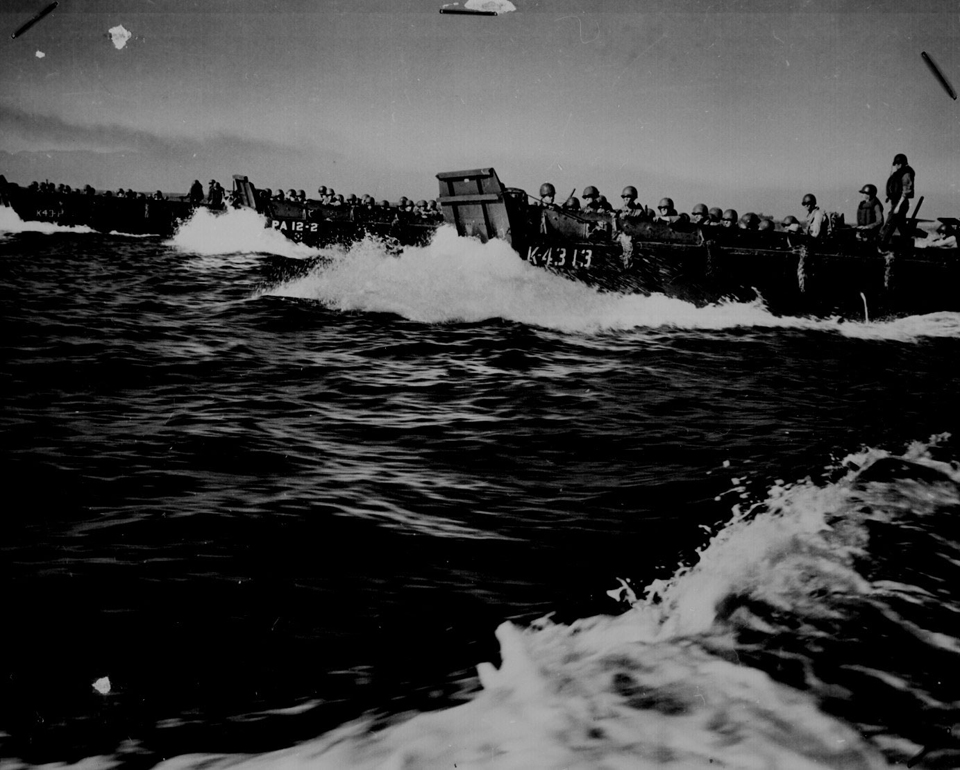 |
|
Holding German POWs
|
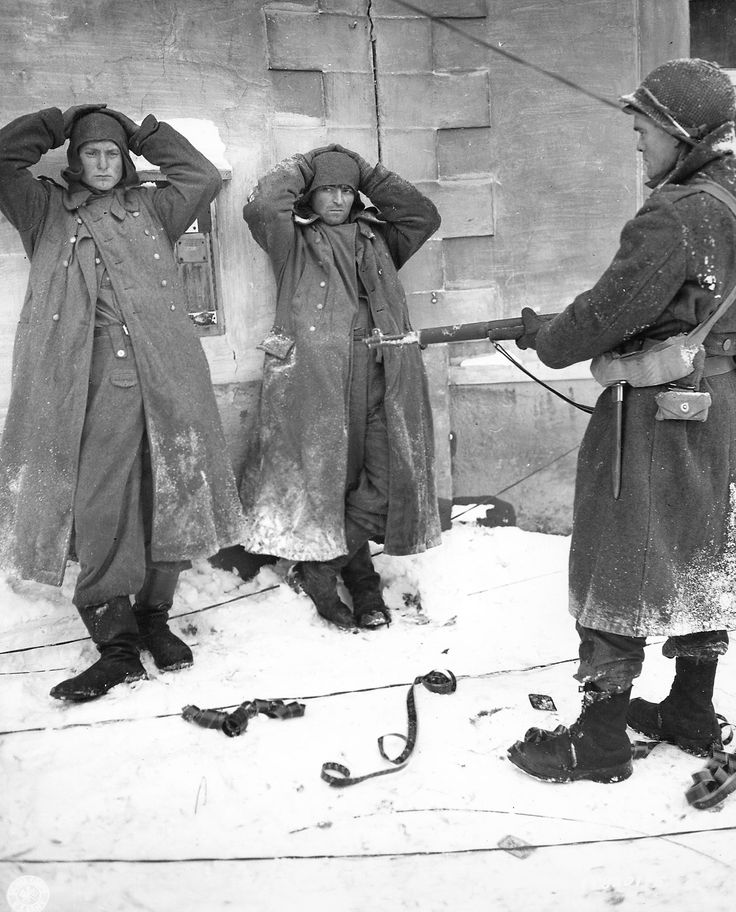 |
|
Landing on Luzon
|
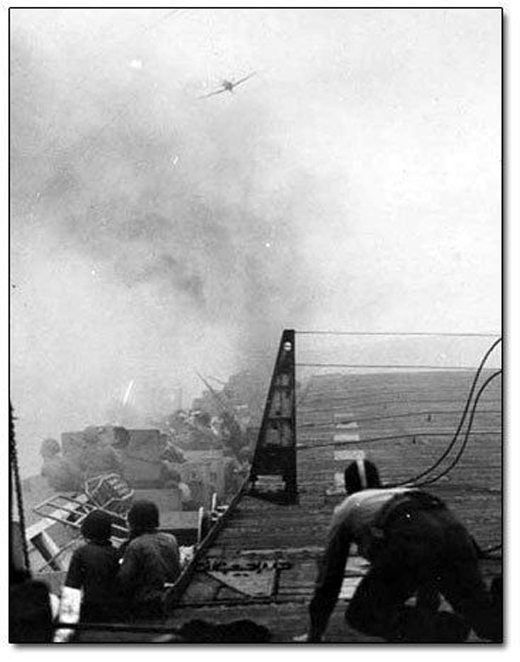 |
|
Wading Through a Stream
|
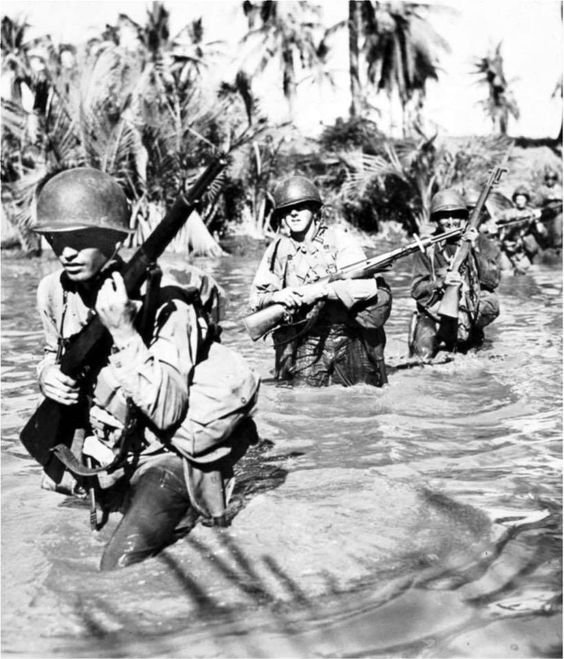 |
|
US Soldiers near Riedwihr, France
|
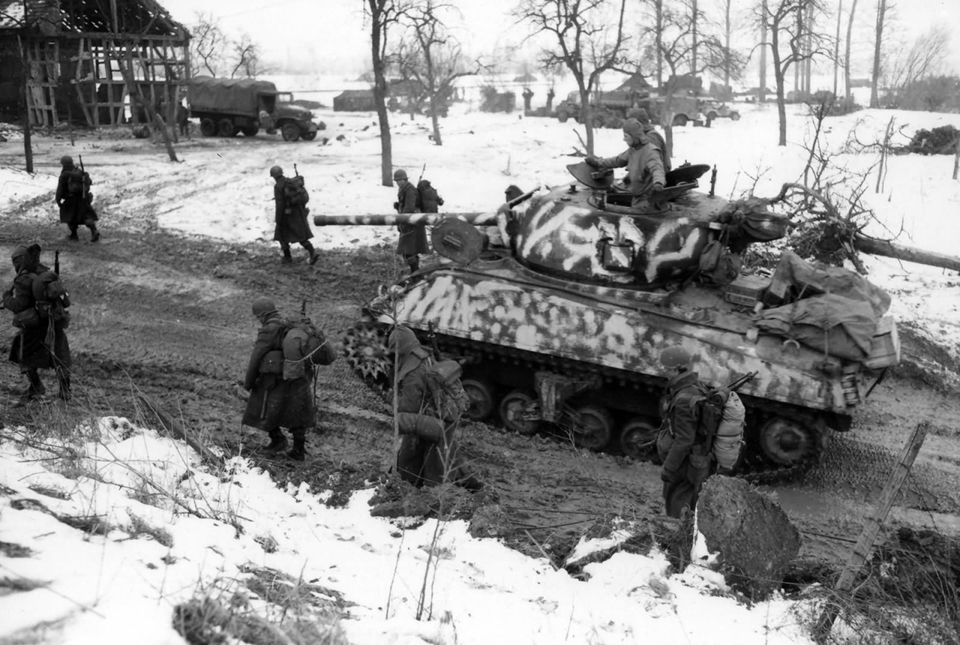 |
|
Knocked-out Japanese Tank
|
 |
|
First Wave on the Beach
|
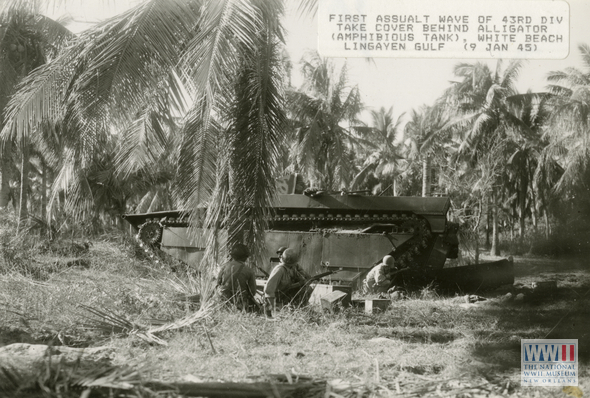 |
|
Captured Germans in Bastogne
|
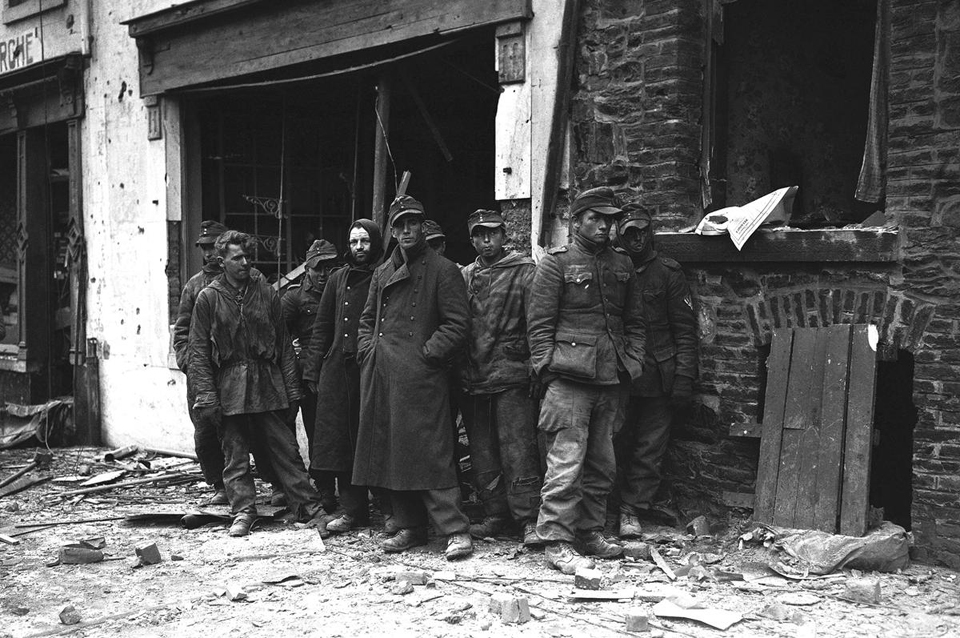 |
|
Moving the Wounded
|
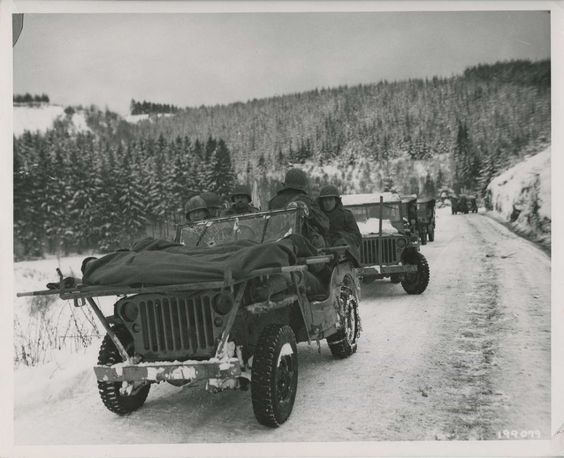 |
|
USS LST-469
|
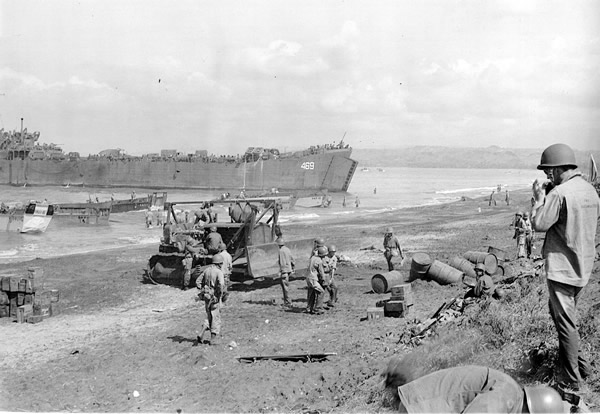 |
|
USS Walke and USS Mississippi
|
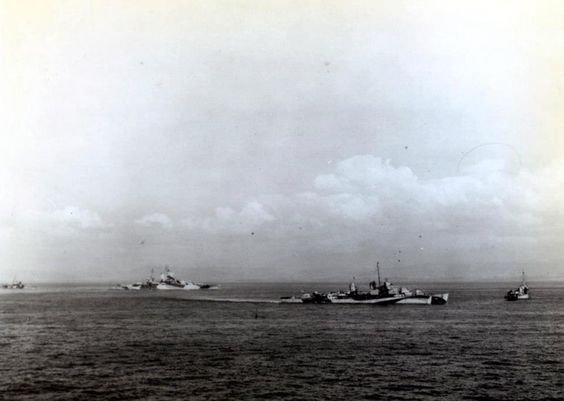 |
|
Patton's Third Army Advances
|
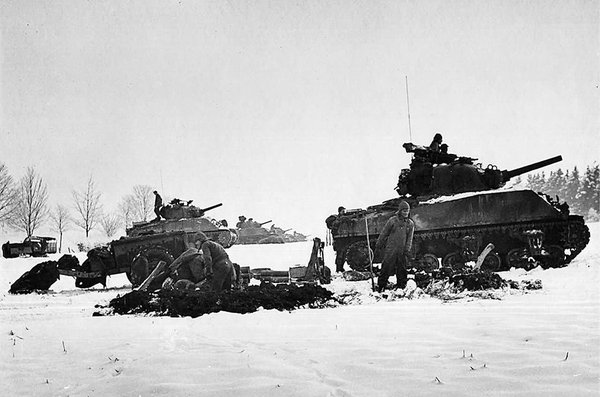 |
|
|











